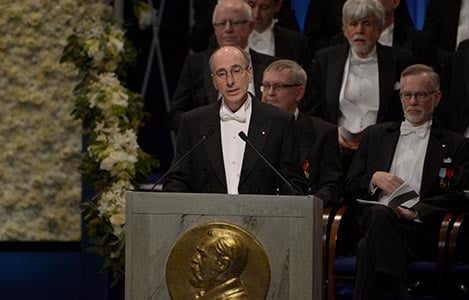Award ceremony speech
English
Swedish
Presentation Speech by Professor Peter Brzezinski, Member of the Royal Swedish Academy of Sciences; Member of the Nobel Committee for Chemistry, 10 December 2017.

Professor Peter Brzezinski delivering the presentation speech for the 2017 Nobel Prize in Chemistry at the Stockholm Concert Hall.
Copyright © Nobel Media AB 2017
Photo: Pi Frisk
What lovely music we have been hearing flowing from the choir loft. In our ears, electrical signals are being generated, nerve cells are activated, and molecules causing pleasure are released and bound to their receptors. These molecules are conducted inside the cells, out of reach of our senses. Even so, these processes allow us to hear the music.
A long-held dream would be fulfilled if we were able to dive into a cell and see the molecules. The world of molecules is the core of what we call life. But molecules are small. If we were able to enlarge your ear sensory organ to the size of this hall, hundreds of protein molecules would fit into each comma in the programme you are holding in your hand.
The electron microscope allows us to “see” these molecules – and even their components: the atoms. This instrument was first invented nearly 100 years ago. But it would take many decades before it could be used to study biological molecules, since they tended to dry up in the microscope’s vacuum and be burned by the electrons used to visualize the samples.
To examine biological samples in an electron microscope, they need to be frozen. Molecules in our cells, however, are surrounded by water that forms ice crystals when it freezes. These crystals are beautiful to look at, but the electrons lose their way in the crystal labyrinth and the images come out black.
Freezing water without forming ice crystals was thought to be impossible. Jacques Dubochet moved to Heidelberg to try to do just this. Out of pure curiosity, he wanted to do something that was considered impossible, something that even lacked practical applications. How would one write a grant proposal for a project of this type? Who would be willing to finance such a project?
In the early 1980s, when Dubochet flash froze water at minus 200 degrees Celsius in cold ethane, he gazed at the impossible. The water was both liquid and solid at the same time. We call this state a glass. Dubochet had thus created a window into the world of molecules.
At around the same time, Richard Henderson was studying a microorganism living in salt-saturated lakes in the desert. This organism has small, well-organised solar collectors made from protein molecules on its surface. In 1990, after having sought out the best electron microscopes in the world, Henderson was able to show the structure of these solar collectors at atomic resolution for the first time. In doing so, Henderson showed that the microscope could in principle provide detailed structures of the thousands of molecules found in our cells.
But finding these molecules in microscope images can be compared to finding a shadow of a bird in the weak glow of the moon. Joachim Frank succeeded in developing methods that made it possible to find these faint molecular shadows. The challenge was then to determine how the molecules are positioned in relation to each other. After more than 10 years work, Frank finally was able to present sharp, three-dimensional models created from thousands of these faint molecular shadows.
In recent years, advances have come quickly. The scientific literature describes the progress as an ongoing revolution. Those of you in the front rows need not be concerned, however. Within science, revolutions are international in nature, they come through collaboration between individuals, and the results confer benefit to mankind.
Some say that it is a miracle that we now, thanks to the contributions of the Laureates, can look into ourselves, thereby tricking our senses. But to quote a famous chemist, “miracles sometimes occur, but one has to work terribly hard for them.”
Jacques Dubochet, Joachim Frank and Richard Henderson: your work has led to the development of cryo-electron microscopy for the high-resolution structure determination of biomolecules in solution. That is a truly great achievement. On behalf of the Royal Swedish Academy of Sciences I wish to convey to you our warmest congratulations. May I now ask you to step forward and receive your Nobel Prizes from the hands of His Majesty the King.
Nobel Prizes and laureates
Six prizes were awarded for achievements that have conferred the greatest benefit to humankind. The 14 laureates' work and discoveries range from quantum tunnelling to promoting democratic rights.
See them all presented here.
